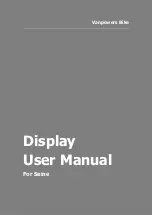
NOTE:
Remove all parts from the packaging and
familiarize yourself with all the parts and tools
required. Use the parts list on the front page to verify
that all parts and hardware are present.
TOOLS REQUIRED
Impact wrench or ratchet.
Sockets sized 15/16", 13mm, & 18mm
15/16", 1/2", 13mm & 18mm Box end wrench
Marking tool (pencil or permanent marker)
4" hole saw Flashlight
Drill with 11/16" bit
Eye protection
Ear protection
Torque wrench
Pry bar
Tape measure
Lifting device (optional)
Pilot hole bit
Screw driver with T−15 bits
Determine cab clearance.
The Turnoverball hitch is
designed so that the ball can be inverted and stored
below the surface of the truck bed while not in use.
The ball location is determined by the truck geometry.
Measure the trailers to be towed with this hitch to be
sure that the location of the 2−5/16" ball listed in Step
5 will provide ample turning clearance between the
nose of the trailers and the cab of the truck.
WARNING:
Cab clearance on short bed trucks is very
limited when towing certain trailers. Failure to ensure
that there will be adequate clearance, may result in
significant property damage, or serious injury.
PREPARE TO INSTALL
1.
Remove the spare tire and shield.
Following the
vehicle manufacturer’s instructions, remove the spare
tire. The spare tire shield is held in place with two
bolts. Using a 13mm socket, remove the shield and
set aside for later re−installation. This will provide
easier access to the area where the hitch will be
installed.
Position the vehicle.
Installation of the hitch requires
the installer to be under the truck bed in the area of
the rear axle. Lifting the vehicle makes this area more
accessible to the installer, and improves the
installation process.
WARNING:
Lift vehicle using only equipment
designed for lifting and positioning vehicles for service.
Failure to do so may result in property damage,
serious injury, or death.
3.
2.
Installation of the Turnoverball hitch requires several
common tools and a few specialized tools. Below is a
listing of equipment used during a typical installation.
Mark the 4" hole location.
Using a tape measure
hooked over the rear edge of the bed (at tailgate
end), measure the location for the hole as shown
in Figure A1. Next, locate the center of the bed by
measuring the distance between the wheel wells
and dividing by two. The center of the hole will be
at the intersection of the center of the bed and the
first distance measured.
IMPORTANT:
The hitch is designed to install only at
the described location. Failure to place the 4" hole
precisely may result in added difficulty during
installation or property damage.
IMPORTANT:
If the bed is equipped with a plastic bed
liner, the hole may be cut through both the liner and
the bed. However, the center of truck bed may be
more difficult to locate, and the mark may be harder to
hit if the liner slides or moves. Failure to cut the hole in
the correct location may adversely affect the install
and may result in property damage.
5.
4" HOLE LOCATION
8’ LONG BED: 45−5/16"
SHORT BED (BED LESS THAN 8’ LONG): 37−1/8"
IMPORTANT:
If your truck has a spray−in bed liner
you will need to take this into account when you are
measuring, and add the thickness of the applied liner
that has been sprayed over the end of the bed.
Lower the exhaust (optional).
On some trucks,
installation may be easier if exhaust is lowered.
Un−attach the rear most tail pipe hangers from the frame
and allow the exhaust to hang freely. Re−attach the
exhaust brackets after installation is complete.
7.
PAGE 2 of 6
Cut the 4" diameter hole.
Cut the hole in the marked
location using a 4" hole saw or by marking out the 4" hole
and using a saber saw equipped with a metal cutting
blade. Remove any burrs created while cutting hole.
6.
8. Un−attach the wheel well liners.
Check for the
presence of flexible wheel well liners in the truck
wheel wells. If present, three T−15 Torx screws will
need to be removed so that the liners can be folded
up and allow access to the frame, see Figure A2.
Retain screws for later re−installation.
Remove the heat shield.
Locate and remove the
heat shield located above the rear axle. Use a 13mm
socket to remove the four bolts holding the heat shield
to the frame.
4.
Figure A1
Figure A2:
View looking into driver side wheel well.
4" H
OLE
LO
CAT
ION
CENTER OF
TRUCK BED
REAR OF
TRUCK BED
T−15 SCREWS
























